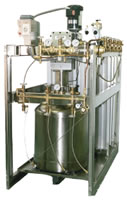Problem Solver
Transfilling Transformation
How some oxygen providers are leveraging liquid-to-gas systems to slash their cylinder refilling costs.
- By David Kopf
- Feb 01, 2010
For oxygen providers, the name of the game is cutting costs. After a year of 9.5 percent cuts, the 36-month rental cap, and the industry’s oxygen benefit reform package left in the congressional doldrums while lawmakers argue over the higher-profile issue of healthcare reform, oxygen providers must contend with drastically reduced margins and narrowing cash flow. This means they must find any and all ways to reduce their costs. (For more on how providers are contending with the changing oxygen landscape, see “Changing the Game.”)

Liquid-to-gas systems such as Andonian Cryogenics Inc.’s HP-40 can drastically reduce refilling costs.
For some providers, cutting their costs means transitioning to a low- or non-delivery business model, and this means adopting technologies such as portable oxygen concentrators or home filling systems. These options work for some providers and patients, but not all. Even then many providers must still engage in at least some cylinder delivery, and driving cost from that model can be much trickier.
One option is to reduce the cost of refilling e-cylinders, and some providers are accomplishing that through liquid oxygen-to-gaseous oxygen transfilling systems. In a liquid-to-gas system, liquid oxygen is being pumped through a vaporizer and turned into a gas. Liquid oxygen is much more dense than gaseous oxygen, so it much cheaper per cubic foot, says Mark Andonian, vice president of New Bedford, Mass.-based Andonian Cryogenics Inc., which makes the HP-40, a self-contained liquid-to-gas transfilling system designed specifically for HME providers.
“This is where the economy comes in,” liquid-to-gas is something that businesses with extremely large oxygen services for various industries have realized for a while. “If we were to look at the large corporations filling for industrial and medical … they have systems where they take liquid oxygen, put it through a vaporizer and fill cylinders.
“What we’ve done is just miniaturize if for the HME provider so that they can buy liquid oxygen,” he continues. “The price per cubic foot for liquid oxygen is considerably less.”
A typical gas refill for oxygen costs approximately 25 to 50 cents per e-cylinder on average, according to Andonian. “If you figure in labor and overhead, it costs maybe an average of a dollar for each cylinder — and a lot of people are paying a lot more than that,” he says. Using the HP-40, providers are seeing costs savings for refills that are as much as 50 percent. And those savings can be even greater if the original refill cost goes much higher.
For instance, Greece, N.Y.-based oxygen provider Monroe Oxygen& Medical Equipment services approximately 800 patients in a billing cycle has seen a massive refill cost reduction according to its president and CEO John Velekkakan, MA, MDiv. Monroe uses an HP-40 to refill its tanks.
“The cost of filling a tank, if I send it out, it costs me approximately $2.50,” he says. “I have about 6,000 tanks, and if I’m filling 6,000 tanks at $2.50, that amounts to $15,000 a month. Now, [with transfilling] my cost for filling each tank is about 55 cents. So, it’s a no-brainer.”
In terms of purchase price, the HP-40 system starts at $24,700 for a provider that is already doing gas-to-gas refills and has a manifold that Andonian can use, Andonian says. A complete system costs $27,365.
For Monroe, Velekkakan says that it took six months to a year to pay off its initial investment of roughly $45,000 when it purchased the system seven years ago.
To help providers determine if liquid-to-gas transfilling Andonian Cryogenics has posted a spreadsheet to its website that lets providers plug in their current costs are for cylinder refills and determine if a liquid-to-gas system makes sense for them. “Many of our customers are realizing tremendous savings, but it’s not for everyone,” Andonian says. “There’s a certain volume that’s required … it all depends on the particulars. We make it a point to ensure that we make a good fit so that our customer is successful. We don’t want any other way.”
Besides some training on the system, handling the HP-40 doesn’t necessarily require new skills on the part of provider staff. In addition to following safe oxygen handling procedures, they must recognize that liquid oxygen is a cryogenic liquid (roughly -350 degrees Fahrenheit, Andonian says). That said, many oxygen providers are already using liquid in reservoirs and in portables, so if an HME is familiar with those systems, it should be more than capable of utilizing the HP-40 Andonian says.
In terms of day-to-day operations, filling tanks is a fairly simple, rapid process Velekkakan says, but providers have to be thorough. “In a typical day, we fill about 200 tanks. But, it’s detail-oriented. We are considered to be repackaging drugs. So our facilities are FDA approved; they come and do site inspections.”
Additionally, there might be local safety regulations providers considering liquid-to-gas transfilling might want to consider. Monroe built a specific room for the system because the area where the provider operates has specific regulations pertaining to such systems. So a completely enclosed room was built per local instructions from the local fire marshal.
“Those are some of the factors [providers] need to take into consideration, and check with the local fire marshals,” Velekkakan says.
This article originally appeared in the February 2010 issue of HME Business.
About the Author
David Kopf is the Publisher HME Business, DME Pharmacy and Mobility Management magazines. He was Executive Editor of HME Business and DME Pharmacy from 2008 to 2023. Follow him on LinkedIn at linkedin.com/in/dkopf/ and on Twitter at @postacutenews.